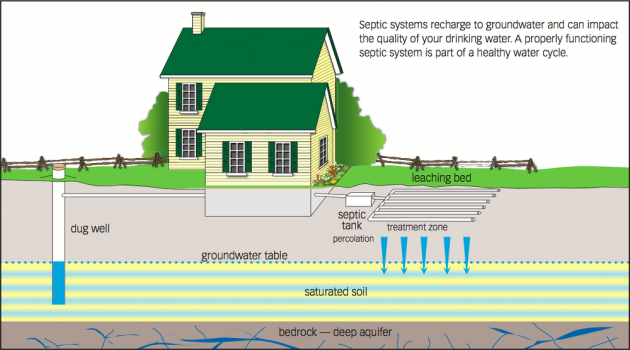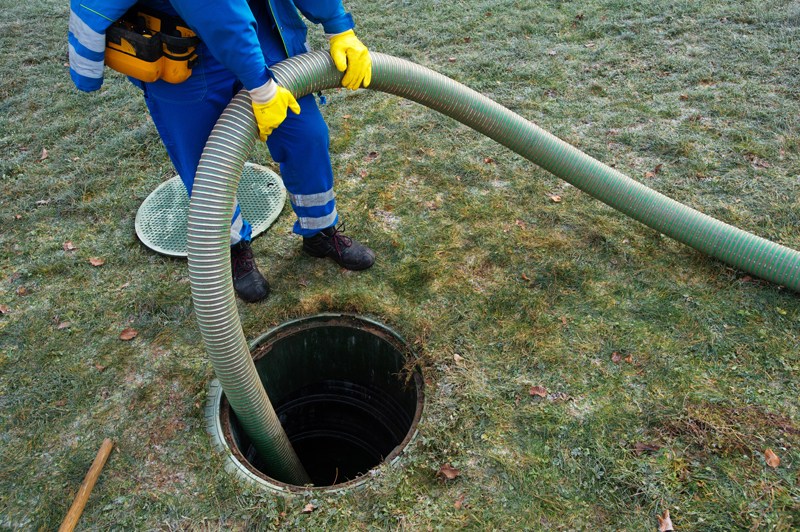
What is a Septic System?
A septic system is a way to handle household wastewater for properties that are not serviced by a municipal sewer system.
The system is buried in the ground and usually consists of a septic tank connected to a network of pipes in a leaching bed.
How do septic systems work?
Household wastewater from the kitchen, bathrooms, and laundry room leaves the house and flows directly into the septic tank. In this tank, any heavy solid materials settle to the bottom. Any lighter solid materials (soap suds, fats, oil, grease) float to the top of the tank and form a scum layer that gradually thickens until the tank is pumped. Beneficial bacteria float around in the tank and break down some of the solids into liquids.
Any liquid material in the septic tank has now been partially treated and flows out to a series of perforated pipes in the leaching bed. Porous materials like sand and gravel act as a natural filter, while beneficial bacteria and soil organisms break down materials to clean the wastewater as it seeps into the ground.
What are common problems with septic systems?
A septic tank accumulates solid waste materials that must be pumped out at regular intervals. If the solids are allowed to accumulate, this sludge may reach the outlet level and begin flowing into the leaching bed where it can plug the pipes or the bed.
When a problem arises in your septic system, there are some warning signs:
- The grass above may become unusually green and spongy
- Toilets, showers and sinks might take longer to drain
- Sewage odours may become noticeable, often after a rainfall
- Grey or black liquids may surface on the yard or back up through plumbing fixtures in the house
If you notice a problem with your system, you are required by law to report it to your local building department before arranging to have it repaired. The building department will issue a permit, and then you can call a licensed contractor. Possible repairs can range from simply clearing a few lines to replacing entire leaching beds or filling up the land where there is contaminated soil. The cost of these repairs can vary from a few hundred dollars to thousands, depending on the problem.
Disclaimer: The following video is for general information. It may not accurately reflect local codes and regulations. For further explanations and questions regarding code and installations please contact a local septic installer.
How long do septic systems last?
If a septic system is built properly (taking into account soil conditions), sized appropriately (taking into account water use in the house), and maintained well, it should last between 20 to 30 years.

How much are septic systems to replace?
The type of septic system for your home depends on factors like the types of soil, site conditions of the land, and household water usage.
A conventional septic system with a septic tank and a number of trenches buried two to three feet deep is used almost half of the time in Ontario. It works well in brightly coloured (red or brown), thick, loamy-textured soils with deep water tables. The average installation cost ranges from $7,500 to $10,000. For larger systems and ones that face certain obstacles, including insufficient space, or the need for a raised bed may cause the price to Exceed $20,000-$25,000.
For soils that are too wet or too shallow, a modified standard system or an alternative septic system may be used.
When fixing a problem in an existing system, remediation costs can vary from hundreds of dollars to $25,000 per system.

How often do you need to pump a septic system?
You should arrange for a licenced contractor to inspect the system every two years and pump out the solids whenever necessary.
The best times to pump out a system are summer and early fall. This avoids problems like the ground being frozen (winter/spring), and it allows the spring water table (which can create buoyancy challenges for septic tanks) to recede. Pumping during summer or early fall leaves enough time for the tank to refill and re-establish beneficial bacteria before winter.
How do I maintain a septic system?
Here are some of the main tasks you’ll need to take care of:
- Fix any leaks
- Be frugal with your water use
- Don’t put garbage, grease, or harmful chemicals or liquids down the drain
- Have your septic system checked every two years (summer and early fall) and pumped when required
- Keep a maintenance schedule on your septic system and record the following:
-
- The physical layout of the system
- The dates it was inspected
- The kind of work done
- The name of the licensed contractor who performed the work
The House
Explore the different components of the house.

